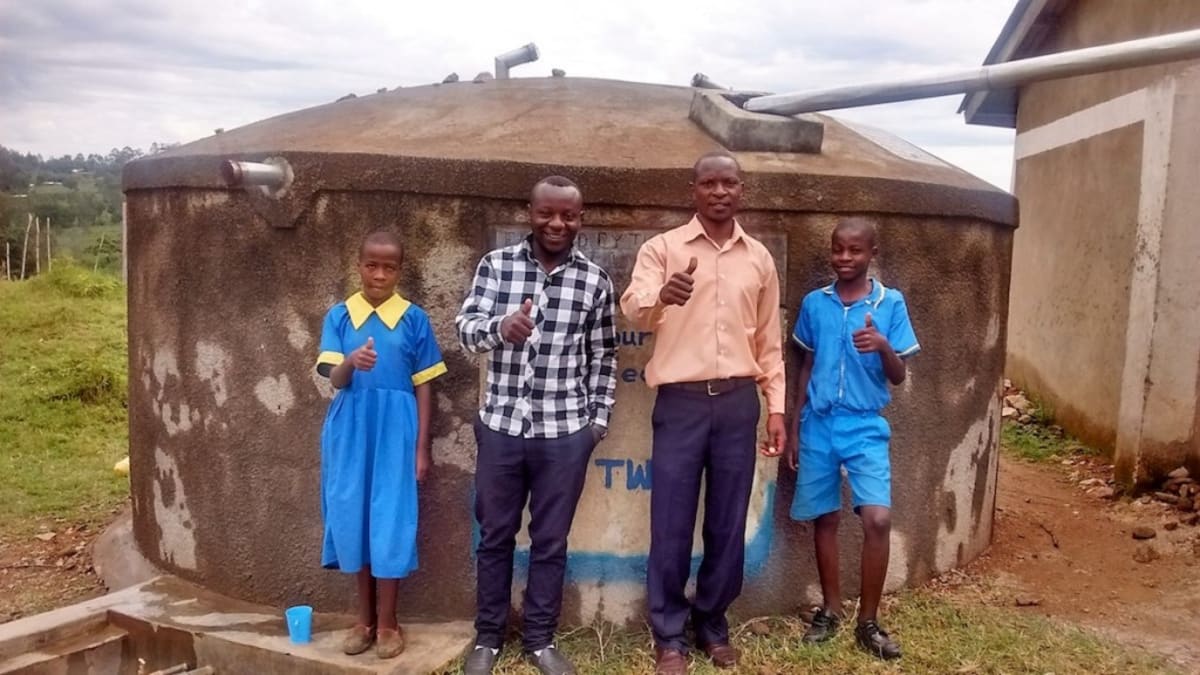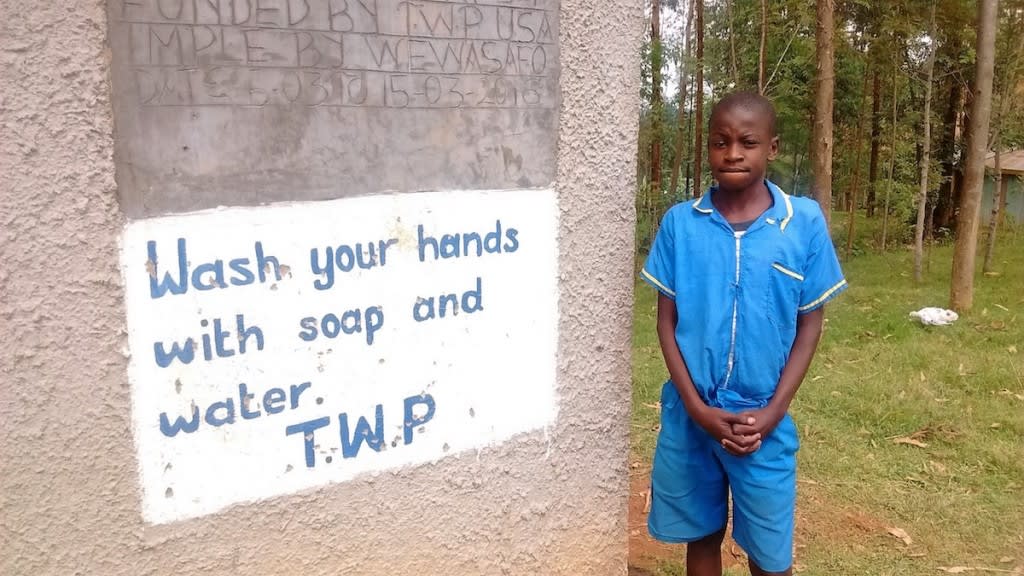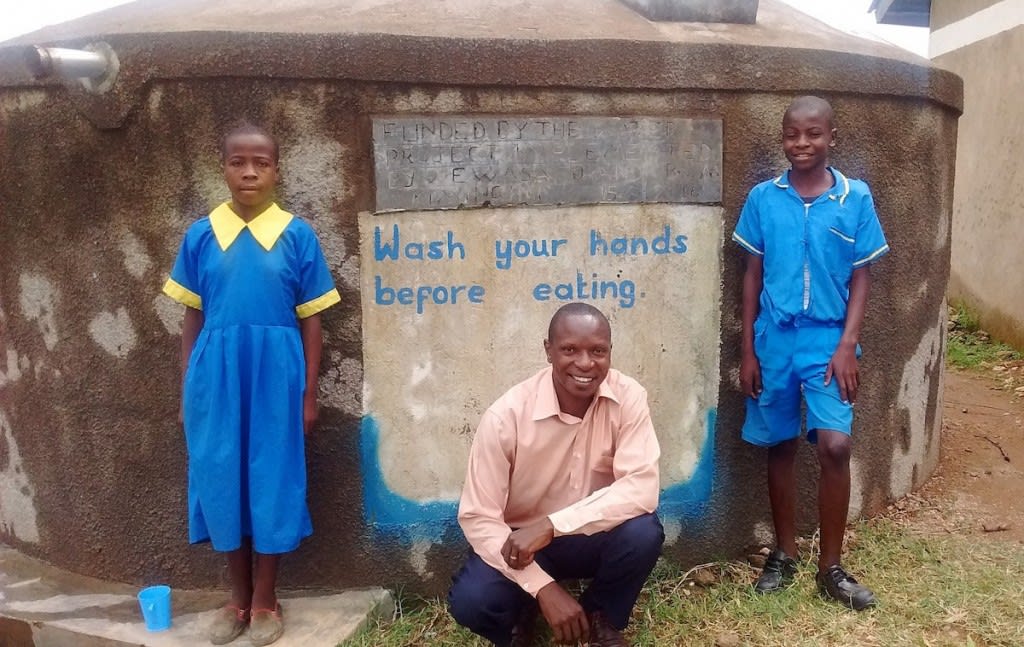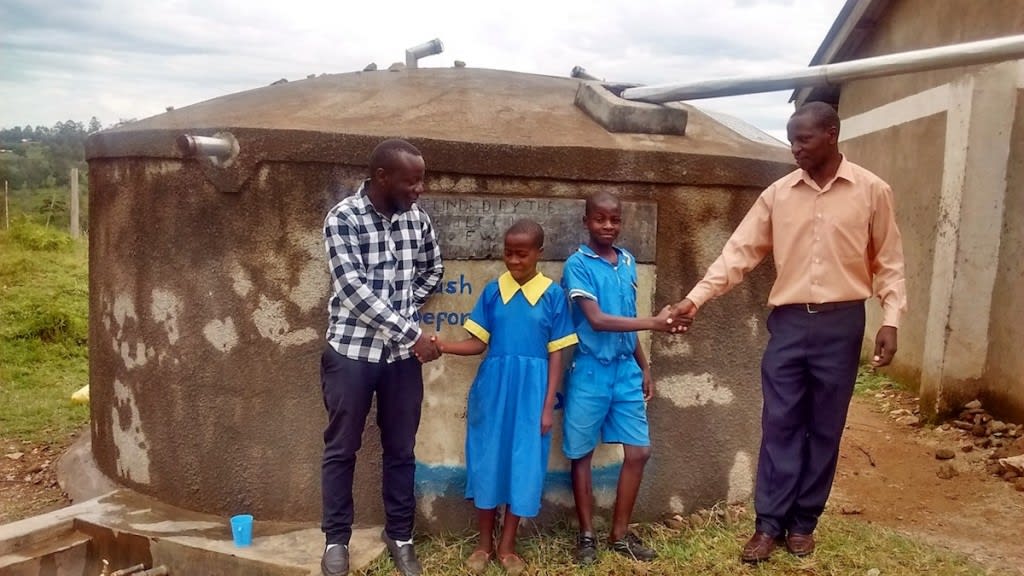This project is a part of our shared program with Western Water And Sanitation Forum (WEWASAFO). Our team is pleased to directly share the below report (edited for clarity, as needed).
Background Information
A normal day in this community begins with women going to fetch water at the spring and then later preparing their children to go to school. Once children are at school, women then proceed with general household chores and then either go to the farm or the market. General activities in this community include farming, mining, and entrepreneurship. Mining of gold is one of the unique activities that makes this location special.
There are 660 students enrolled at Kimingini Primary School, with 12 teachers and two supplementary staff. (Editor’s Note: While this many people may have access on any given day, realistically a single water source can only support a population of 350-500 people. This site would make a great location for a second project. To learn more, click here.)
The school lacks a proper rainwater catchment tank, so the pupils are forced to go and collect water from an unprotected spring one kilometer away. A lot of time which would have been spent improving academic performance is now wasted with numerous trips to this spring.
The Current Source
Children use jerrycans to gather water from the unprotected spring. They scoop using smaller plastic containers to fill the larger ones, the majority of which lack covers. These containers and jerrycans are washed using maize cobs, sand, and water. Once children get the water to school, it is stored in either the same plastic containers or mud pots.
It is obvious the spring is contaminated because of the negative effects that emerge soon after drinking. Children suffer from waterborne diseases even when they boil the spring's water before consumption. It is also obvious that the spring is constantly affected by surface runoff, human and animal activity, nearby farming, nearby latrines, and soil erosion.
Sanitation Situation
The initial visit to the school established that the school sanitation situation seriously needs to be addressed. There are only 10 latrine doors for boys and six doors for girls. All of the boys' latrines have been condemned, and the girls' latrines are in extremely poor condition. There are only two doors for teachers. Kimingini Primary School does not have any hand-washing facilities. The school compound consolidates its garbage in a compost pit, but this pit is already full. Occasional burning of the garbage helps supplement the full pit. This poor sanitation situation compromises hygiene standards and exposes pupils to a high risk of contracting waterborne diseases like typhoid, cholera and diarrhea. Families must then spend their saved money on treating these instead of on education or food, and sometimes medication is just not enough. There have been cases of premature death in this community.
Training Sessions
WEWASAFO staff observed that there is a great lack of knowledge concerning good hygiene and sanitation practices. Students, staff, and many others will benefit from training sessions held at the school. During training, participants will also learn about necessary contributions if this project is to be a success: Ballast, clean sand, bricks, hardcore, and sugar sacks. Locals will also have to provide food, accommodations, and security for the construction teams. The locals themselves will have to sink pits seven feet deep for the latrines.
Training will be held at Kimingini Primary School for two days. The facilitator will train teachers, students, staff, and three PTA members. They will teach using the CTC (child to child) method, group discussions, lectures, demonstrations, and handouts. The CTC utilized during training targets the students, empowering them to be agents of change in their classrooms and greater community. When other children see student leaders embracing good health practices, they will be more likely to adopt those practices themselves. Training will also kickstart a CTC club on campus, and students will be responsible for recruiting new members.
The entire Kimingini Primary School fraternity is appealing to the donor through WEWASAFO to consider their situation and assist them in constructing a proper rainwater catchment tank and VIP latrines. They believe by doing so, sanitation standards will improve significantly and thus translate to better performance among pupils.
Construction
A new 30,000 rainwater catchment tank is planned for this school compound. Once the tank has been through a rainy season, it should have more than enough water to last students and staff for quite some time. Six VIP latrines will also be constructed, three for boys and three for girls. Since now hand-washing stations were observed during the initial visit, two will be installed in the latrine area. These stations are 500-liter containers fitted with taps. The CTC club will make sure that these hand-washing stations are always filled with enough water.
Project Results: Training
Training was held in a school classroom on a date determined best by the head teacher. Participants were pupils from grades five to seven, as well as teachers in charge of health and sanitation. There were also some parents present. In total, there were 12 participants actively involved during sessions. If students didn't understand something, they would immediately raise their hands for clarification. Teachers would also present their questions, and the parents were very curious to learn as much as they could in order to be good ambassadors of health in their greater community.
Topics covered were:
- Primary Health Care
- CTC Formation and Member Responsibility
- Child Rights
- Operation and Maintenance of the Rainwater Catchment Tank
- Sanitation Facilities and the VIP Latrines
After training, Student President Felix Mulama said that "This training has really helped me know how to uphold high hygiene and sanitation standards thus my health is guaranteed to improve!"
VIP Latrines
VIP latrine construction is now complete and in use by students. The additional latrines have helped reduce the long lines previously experienced. Pupils like using the newly constructed latrines because they consider them very clean and without smell.
Hand-Washing Stations
The two hand-washing stations were delivered and installed and are now in use. Students were trained on proper hand-washing, and both boys and girls are happy using these facilities. They admitted that before, they would eat before washing their hands because they lacked hand-washing facilities and water was also too scarce. Now the pupils are observing good hygiene practices!
Rainwater Catchment Tank
Construction for this 30,000-liter tank began on January 1st. The process began with site clearance, setting and casting the foundational slab, construction of the wall, roofing, and installation of fittings such as delivery pipes, vent pipes, and screens. Finally, good drainage was ensured.
The only challenge encountered was that it took longer than usual to mobilize the local materials needed. This was the responsibility of the community, and so construction was delayed slightly as materials were slowly delivered.
Cases of absenteeism in the school have already decreased. With the availability of water within the school, girls are now motivated to attend school since they were previously the ones being sent in search of water. The risk of sexual harassment for those girls fetching water very early in the morning will decrease and give them greater safety and confidence. The teachers are also happy that the burden of worrying about girls as they fetch water is no longer, and thus time can be used effectively in the classroom. Some other pupils no longer have to be punished by their parents when they return home without water jars that were stolen by fellow pupils. And the high risk of contracting waterborne diseases like typhoid, cholera and diarrhea has already decreased.
The school chairman, Mr. Ronald Makamu said, ''With this tank you have really helped our school since the academic performance will improve tremendously since the students have all the time to concentrate on their studies. Thank You!" He also added "I am optimistic my school will be one of the best performing schools in Kakamega County as a result of having safe water."

 Rainwater Catchment
Rainwater Catchment
 Rehabilitation Project
Rehabilitation Project






















 “We also noticed full classrooms with some students having to share desks,” said Allan. “Mr. Ngaira, Head Teacher, accredited this to fewer cases of absenteeism and increase in the number of students enrolling because of the WASH facilities at the school. The school’s records show an increase in the population of pupils from 668 when the project was installed in 2016 to 713 in May 2017. Most of the newly enrolled pupils were girls from neighboring schools who wanted a convenient environment for learning, the presence of adequate, clean water and sufficient sanitation platforms which Kimingini Primary School now has.”
“We also noticed full classrooms with some students having to share desks,” said Allan. “Mr. Ngaira, Head Teacher, accredited this to fewer cases of absenteeism and increase in the number of students enrolling because of the WASH facilities at the school. The school’s records show an increase in the population of pupils from 668 when the project was installed in 2016 to 713 in May 2017. Most of the newly enrolled pupils were girls from neighboring schools who wanted a convenient environment for learning, the presence of adequate, clean water and sufficient sanitation platforms which Kimingini Primary School now has.”
 A year later, Kimingini Primary School is managing their project very well. As we continue to monitor their progress, we’re excited to hear and share more stories from this primary school and their successful students. “We are not going to the river wasting a lot of time, our school is now very clean, cases of absenteeism are minimal and we are enjoying being in school,” Felix Mulama said.
A year later, Kimingini Primary School is managing their project very well. As we continue to monitor their progress, we’re excited to hear and share more stories from this primary school and their successful students. “We are not going to the river wasting a lot of time, our school is now very clean, cases of absenteeism are minimal and we are enjoying being in school,” Felix Mulama said.